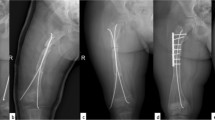Abstract
The purpose of this study was to analyse the complications using the Bailey-Dubow expanding intramedullary rods in patients with osteogenesis imperfecta. Between 1985 and 1996 intramedullary rodding of 107 long bones with expanding Bailey-Dubow rods was performed in 29 patients suffering from osteogenesis imperfecta. Indications for using rods included osseous deformities and bone deformities in combination with fractures. The average follow-up was 3.5 years (range 2 months to 9 years). The total complication rate in these patients was 63.5% (68 rods). The main complication was rod migration often combined with perforation of joint, bone and soft tissue. Additionally, there was a high incidence of new fractures as well as refractures. Other complications like infections, pseudarthrosis, lack of elongation or over-elongation of the rods, and loosening of the T-piece were only rarely seen. Based on our experience and the information available in the literature, the Bailey-Dubow rod is currently the most successful way to stabilize the growing long bones of patients suffering from osteogenesis imperfecta. However, when using this device, the surgeon as well as the parents of the patient must be aware of the high incidence of complications.
Similar content being viewed by others
Author information
Authors and Affiliations
Additional information
Received: 18 April 1997
Rights and permissions
About this article
Cite this article
Jerosch, J., Mazzotti, I. & Tomasevic, M. Complications after treatment of patients with osteogenesis imperfecta with a Bailey-Dubow rod. Arch Orth Traum Surg 117, 240–245 (1998). https://doi.org/10.1007/s004020050236
Issue Date:
DOI: https://doi.org/10.1007/s004020050236




